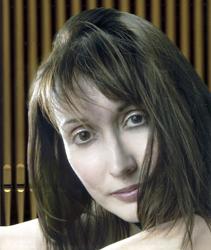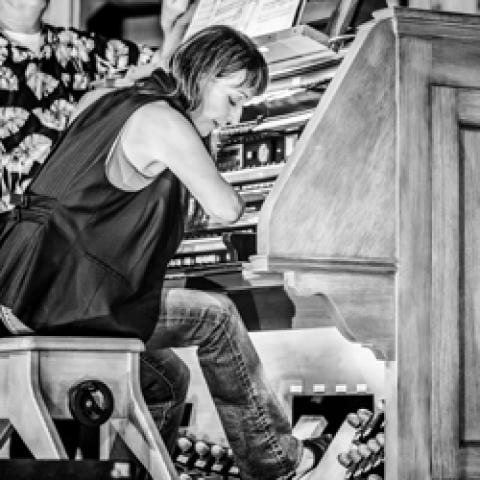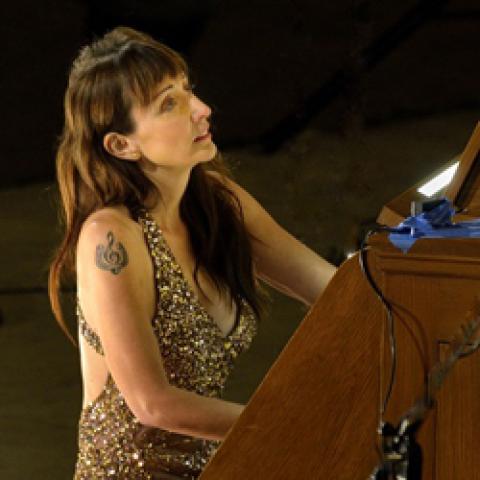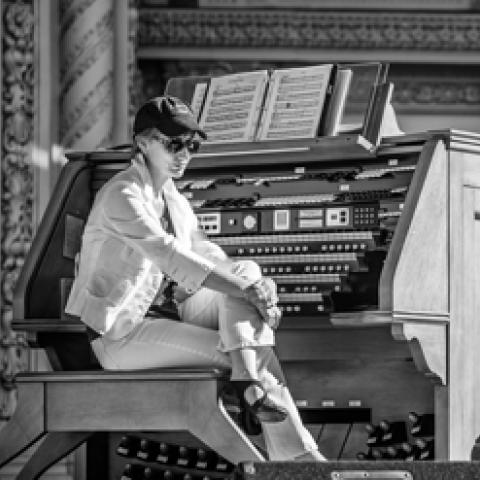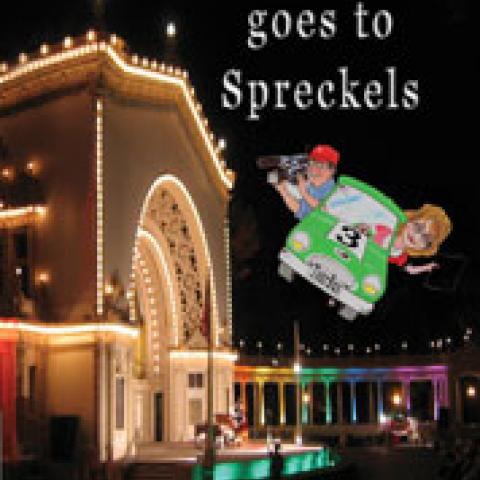A recent holiday in Scotland provided many opportunities to see and play organs and other historical instruments in addition to being a tourist in this beautiful country. My children and I spent two weeks visiting friends in St. Madoes. Using this village between Perth and Dundee as our home base, we toured much of the country and experienced Scottish history and hospitality firsthand. The trip was made possible in part by a scholarly/artistic grant from Ripon College.
Our first stop was Edinburgh. En route to the Castle we wandered into St. Giles' Cathedral, where John Knox initiated the Scottish Reformation in 1560. The Chancel Choir of the First United Methodist Church of Lubbock, Texas, was rehearsing in preparation for a lunchtime concert, and I heard Mozart's Ave Verum Corpus accompanied on the beautiful 1992 Rieger. The organ is one of the instruments featured on the 2-CD set, Twelve Organs of Edinburgh.1
The next organ I saw, and the first one I played, was in Old Saint Paul's [Scottish Episcopal] Church in Edinburgh. Built by Henry "Father" Willis in 1888 and subsequently refurbished in 1905, 1936, 1960, 1968 and most recently, by Nicholson's of Worcester in 1977, the specifications are as follows:
Great
16' Dulciana
8' Open Diapason I
8' Open Diapason II
8' Stopped Flute
8' Dulciana
4' Principal
4' Spindle Flute
22/3' Twelfth
2' Fifteenth
III–IV Mixture
8' Trumpet
Swell
8' Open Diapason
8' Lieblich Gedackt
8' Salicional
8' Celeste (TC)
4' Gemshorn
III–IVMixture
16' Contra Oboe
8' Cornopean
Tremulant
Pedal
32' Subbass (derived)
16' Open Diapason (wood)
16' Bourdon
16' Dulciana (Great)
8' Octave (ext)
8' Bass Flute (ext)
8' Dulciana (ext)
4' Super Octave (ext)
4' Octave Flute (ext)
4' Dulcet (ext)
16’ Trombone (ext Trumpet)
8' Trumpet (Great)
The organ has a rich, warm sound eminently suitable for both service accompaniment and solo organ repertoire. A sample of the former may be heard on the CD Hearts & Voices, Hymns sung by the Choir of Old Saint Paul's Church.2
The following day I was privileged to spend several hours playing instruments in the Russell Collection of Early Keyboard Instruments in St. Cecilia's Hall at the University of Edinburgh. John Kitchen, Senior Lecturer and College Organist, was my tour guide as we worked our way through two rooms of virginals, spinets, and harpsichords from the 16th to 19th centuries.3 There were also three organs in the collection, and this seems the most appropriate place to mention them.
The first is an enharmonic chamber organ built by Thomas Parker in 1765. Parker was a pupil of Richard Bridge, a London builder favored by Handel.4 Bridge himself was supposedly trained by Renatus Harris. The instrument has one manual with the usual short octave at the bottom. The real curiosity is a set of levers, two on each side of the case above the keyboard, that allow the player to select accidentals: Ab or G# and Bb or A# on the left-hand side, Db or C# and Eb or D# on the right. Parker provided a set of pipes for each pitch and the organ case is correspondingly wider than that of the usual chamber organ. What a fascinating way to learn firsthand about mean-tone tuning! It's also interesting to imagine how a player would handle a chromatic piece—assistants might be required to change the levers during a performance. The four registers of the organ include a Stopt [sic] Diapason 8', Open Diapason 8' (which only extends to tenor C, requiring both diapasons to be played together in order to use the full range of the keyboard), Principal 4', and Fifteenth 2'. Dr. Kitchen has recorded Stanley's Voluntary in G, op. 7, no. 9, and Handel's Fugue in A minor, op. 3, on the Parker organ.5 Interestingly, Parker built a second, two-manual enharmonic organ for the Foundling Hospital in 1768.
Another 18th-century chamber organ dates from 1763, the date when St. Cecilia's Hall opened. The organ was used in concerts until the hall closed in 1798. (The hall, having been refurbished in the 1960s, is once again the venue for concerts featuring instruments from the Russell Collection.) The third instrument, located in the Newman Gallery, is a Bernard "Father" Smith chamber organ from c. 1680. The specifications, which consist entirely of divided stops, are:
Bass
8' Diapason Bass
4' Principal Bass
2' Fifteenth
Treble
8' Diapason Treble
4' Principal Treble
2' Octave Treble
[rebuilt by Mander]
Wind is supplied through either a foot bellows or a modern electric blower. All of the above chamber organs reflect the disposition of English organs built after the restoration of the monarchy in 1660; i.e., principal stops at 8', 4', and 2' and, in the case of the Parker, stopped diapasons at 8'. The conventional registrational pattern of the time included solo stops plus accompaniment (hence the usefulness of the divided stops arrangement), diapasons (open plus stopped) for slow introductory movements, and full organ (8', 4', and 2') for faster movements. Stephen Bicknell has suggested that "There was a considerable revival of interest [in chamber organs] in the second half of the 18th century contemporary with (and perhaps because of) the great popularity of Handel, who seems regularly to have used small or even portable organs when playing continuo and for the performance of organ concertos as interludes to larger works."6 Bicknell also states that
By the end of the eighteenth century the chamber organ was firmly established as the instrument of choice for a well-to-do household, challenging both the harpsichord and the emerging fortepiano. The relative stability of tuning compared to a stringed keyboard instrument must have been an advantage, but it should also be noted that a small organ is a good vehicle not just for keyboard music, but also for transcriptions of instrumental works, and could readily be used for the accompaniment of family prayers.
He concludes that the organ's qualities of "reliability, versatility and dignity" must have accounted for its popularity.7
A greater contrast with these historical instruments than the McEwan Hall organ at the University of Edinburgh cannot be imagined. Built by Robert Hope-Jones in 1897, rebuilt by Henry Willis in 1953 and by Rushworth and Dreaper in 1980, the organ has problems because of the disparate placement of its divisions (the hall was designed without provisions for an organ, even though it was common for municipal concert halls at that time to include large instruments). Nonetheless, the organ sounds grand in the reverberant acoustics of the hall, where university graduations are held. The console looks a bit like a Jules Verne creation with its pressure gauges and electric dials, one of which is connected to the swell pedal to show incremental gradation (or "incremental frustration" as it's known to players).
The preceding organ and those described below all date from the second half of the 19th century, living testaments to the phenomenal rate of growth in organ building in England between 1860 and 1900. A few statistics tell the tale: in 1898, Harrison & Harrison of Durham claimed to have built 1,100 organs since 1861. Norman & Beard of Norwich produced even more astonishing numbers: between 1898 when their new factory was built and 1915 the company built over 1,000 new organs. In comparison, Sauer of Germany reached opus 1,000 only after fifty years of activity.8 Reasons for the rapid expansion in English organ building are numerous and include the wholesale replacement of older instruments, particularly those with a limited compass, increased prosperity of the middle class, which paid for new church instruments, and the construction of municipal concert halls in towns of any size.
The next organs I played were in Dundee, the fourth-largest city in Scotland. Three distinguished instruments exist in a three-block area in the heart of the city, which is pleasant and pedestrian-friendly. The first organ is located in St. Mary's Parish Church (Church of Scotland). I had not called ahead—in fact, I was simply being a tourist walking about Dundee and decided to poke my head in since the front door was open. Upon seeing the rich interior and a magnificent display of pipes in the rear balcony, I asked the volunteer guide if I might look at the organ. She very graciously assented, and I was delighted to discover a large three-manual instrument built in 1865 by Forster and Andrew of Hull and subsequently rebuilt by Rothwell (1939) and J. W. Walker (1969 and 1988). The console was open and inviting, so it was only a matter of minutes before I was actually playing. The specifications are:
Great
16' Double Diapason
8' Open Diapason 1
8' Open Diapason 2
8' Stopped Diapason
4' Principal
22/3' Harmonic Flute
2' Twelfth
2' Fifteenth
II Sesquialtera
IV Mixture
16' Double Trumpet
8' Trumpet (ext)
4' Clarion (ext)
Swell
8' Open Diapason
8' Viola da Gamba
8' Voix celeste
4' Principal
4' Lieblich Flute
2' Flageolet
III Mixture
16' Contra Fagotto
8' Cornopean
8' Oboe
4' Clarion
Super Octave
Sub Octave
Choir
8' Rohr Flute
8' Salicional
4' Gedeckt Flute
22/3' Principal
2' Nazard
2' Flautina
13/5' Tierce
11/3' Larigot
III Cymbel
8' Krummhorn
16' Double Trumpet
8' Trumpet (ext)
4' Clarion (ext)
Pedal
16' Open Diapason
16' Sub Bass
8' Flute Bass (ext)
8' Violoncello (ext)
4' Choral Bass (ext)
16’ Trombone
8' Tromba (ext)
A full battery of couplers and pistons plus an 8-channel memory system makes this organ suited for many kinds of repertoire. I only had time to try a voluntary by Stanley and a Buxtehude toccata before my younger daughter came looking for me (I'd left her and her sister parked outside), but I was impressed by the sound and feel of the organ in this parish church that in 1990 celebrated its octocentenary.
My serendipitous sampling of organs in Dundee continued on another day at St. Paul's Episcopal Cathedral. As churches go in Scotland, it is rather new, the cornerstone having been laid in 1853. The organ was built by Hill and Son of London in 1865, the year of the Cathedral's consecration. Hill, Norman and Beard reconstructed the instrument in 1975. Like the organs I saw in other British churches (with the exception of St. Mary's), this instrument is located in the choir with the pipes facing the singers. The organist's back is to the choir. The disposition of this large organ is similar to St. Mary's:
Great
16' Double Diapason
8' Open Diapason
8' Stopped Diapason
8' Gemshorn
8' Viole d'amour
4' Principal
4' Harmonic Flute
22/3' Twelfth
2' Fifteenth
IVMixture
8' Grand Trumpet
Swell
8' Open Diapason
8' Stopped Diapason
8' Viole d'orchestre*
8' Viole Celestes
4' Principal
2' Fifteenth
II Mixture
16' Shalmey
8' Cornopean
8' Oboe
4' Clairon
Suboctave
[Super] Octave
Choir
8' Lieblich Gedeckt
8' Gamba
4' Suabe Flute
2' Flautina
11/3' Larigot
8' Grand Trumpet
8' Clarinet
Sub Octave
[Super] Octave
Tremulant
Pedal
32' Harmonic Bass
16' Bourdon
16' Echo Bourdon**
16' Open Diapason
8' Bass Flute
8' Octave
4' Super Octave
4' Flute
2' Octave
16' Trombone
4' Clairon
Sub Octave
[Super] Octave
Unison Off
Tremulant
Swell & Choir under expression
Sw-Ch, Sw-Gt, Ch-Gt, manual-pedal couplers
General (4) and divisional pistons
* Very stringlike; works especially well with the Viole Celestes
** Enhances the Bourdon 16'
As was the case at St. Mary's, I was allowed access to the organ by helpful parishioners. When I arrived at St. Paul's on a Saturday morning, the only person I could find on the premises (even though the front doors were wide open and a charity hamburger stand was getting ready to open for business on the front steps) was the verger. He led me to the instrument, turning on power switches and lights as we went, saying "We have to show you Scottish hospitality!" I played for an hour, trying out various sounds and combinations and finally let it rip with the Widor Toccata. Feeling self-indulgent but happy with the sonic results, I set about changing my shoes and packing up when I was startled by two members of the flower committee who appeared and thanked me for playing. They told me that people in the street, hearing the music, had stopped to peer inside the church, probably wondering if a wedding were in progress.
A third large organ exists in Dundee within blocks of St. Mary's and St. Paul's. Situated approximately midway between the two churches is Caird Hall, Dundee's civic auditorium. The organ was built in 1922 by Harrison & Harrison to a design by the famous blind organist of Edinburgh, Alfred Hollins. The Caird Hall organ was Harrison & Harrison's first concert hall organ; as such it differs from some of their other instruments in having brighter reeds (on heavier pressure than usual) and more orchestral colors than the average church organ. In 1991 the organ was restored by the original firm with only minor changes to its original sound. No tonal changes were made, but the pitch was raised to make the organ usable with other instruments. Carlo Curley played the rededication recital on this occasion. A stoplist follows:
Great
16' Double Geigen
16' Bourdon (wood and metal)
8' Large Open Diapason
8' Small Open Diapason
8' Geigen
8' Hohlflute
8' Rohrflute
4' Octave
4' Waldflute
22/3' Octave Quint
2' Super Octave
IV Harmonics 17,19,b21,22
16' Contra Tromba
8' Tromba
4' Octave Tromba
Swell
8' Open Diapason
8' Stopped Diapason
8' Echo Salicional
8' Vox Angelica
4' Octave Geigen
4' Stopped flute (metal)
2' Fifteenth
V Mixture 12,19,22,26,29
8' Oboe
8' Vox Humana
Tremulant
16' Double Trumpet
8' Trumpet
8' Horn
4' Clarion
Orchestral Organ
16' Double Salicional (metal)
8' Viole d'Orchestre
8' Violes Celestes (to FF, 2 ranks)
8' Harmonic Flute
4' Concert Flute (harmonic)
2' Harmonic Piccolo
16' Cor Anglais
8' Corno di Bassetto
8' Orchestral Oboe
Tremulant
8' Tuba (unenclosed)
Pedal
32' Double Open Wood (FFFF)
16' Open Wood
16' Open Diapason (metal, leathered)
16' Geigen (Gt)
16' Salicional (Orch organ)
16' Subbass (Gt)
8' Octave (wood)
8' Flute (Gt)
16' Ophicleide (metal)
16' Trombone (Gt)
8' Posaune
The organ's pneumatic action has been fitted with an electronic memory, and the combination pedals removed and replaced with toe pistons. Otherwise, the instrument remains as it was originally. A concert series in the early autumn featured the organ and it was recorded in October 2004. I was unable to play the Caird Hall organ because of a guitar festival in progress, but the staff was most helpful in showing me the console and wind system and providing me with specifications for the instrument.
Some general observations can be made, at this point, about the organs I saw in Scotland. The large instruments are originally from the 19th century and are based on an orchestral tonal design with a preponderance of stops at 8' pitch. The pedal divisions rely heavily on extensions from the manuals. Bicknell identifies the philosophy underlying this esthetic as ‘build-up:' "the gradual crescendo from piano to fortissimo achieved by adding stops one by one, [which] seems to be the dominant characteristic of these Victorian instruments."9 It works in this wise: flue pipes come in many colors, from clear and fluty to reedy with harmonic overtones. As the flues approach the reedy end of the spectrum, mild strings and reeds come into play, creating a smooth blend. Swell-to-Great couplers further increase fullness of sound while masking any addition of single stops, and the Swell pedal also assists in creating a smooth crescendo. As Bicknell points out,
This manner of playing was later to become an idée fixe with English builders and players . . . As a method it was taken so much for granted that it can safely be assumed that Willis's mixtures were not usually intended to be heard unless some reeds were already drawn . . . there is no provision for a chorus of principals and mixtures that can be used extensively on its own: this is . . . in complete contrast to German taste.10
Although the reference is to instruments built by Willis, the description is general enough to be applied to other large late-19th and early 20th-century organs.
Perhaps it seems incongruous that all of the organs I saw and played in Scotland were built by English firms. Were there no Scottish organbuilders in the 19th century and earlier? Regardless of how we might think of Britons as members of a United Kingdom, there are national differences among the English, Scots, Welsh, and Irish. A bit of research was necessary to unearth information about organbuilding in Scotland, from which a clearer picture emerges of the past three centuries.
At the heart of the question is the ban on instruments in church issued by the Church of Scotland from the Reformation (around 1560) until around 1868.11 Organs were allowed for concerts and domestic use, but none were built or installed in this denomination until a very late date. Other denominations—the Episcopal, Roman Catholic, Unitarian, Congregationalist, and Baptist churches—were exempt, and instruments dating from the 18th century are known to have existed in them.12 Early 19th-century Scottish organbuilders, including Small, Bruce & Co of Edinburgh, John Renton, also of Edinburgh, and Robert Mirrlees of Glasgow, specialized in chamber organs, at least two of which are extant.13 I was very surprised to learn that the oldest surviving Glasgow-built organ was made by James Watt in 1762. The renowned engineer and inventor, associated more with the first steam engine than with pipe organs, constructed a single-manual instrument concealed in a table. It was the first of three organs built by Watt.14
In the second half of the 19th century, other firms arose in Dundee, Aberdeen, and Edinburgh, but they found it difficult to compete with the well-established English builders. An admittedly cursory search for information on Scottish builders in the 19th and early 20th centuries produced nothing—but perhaps a written history is in progress.
Today, Lammermuir Pipe Organs (est. 1983) is perhaps the best-known firm in Scotland and the only workshop "north of the border" specializing in new, mechanical-action organs.15 Op. 50 is scheduled for completion in 2005. The other company listed in an Internet link to pipe organ builders in the United Kingdom is Michael Macdonald (est. 1975) of Glasgow.16 Interestingly, besides building new instruments, Macdonald engages in rescuing historic organs from redundant buildings (primarily churches closed due to dwindling congregations).
I would like to think of my visit to Scotland as a prelude to further organ crawls there and in other parts of the United Kingdom. There are many instruments to be played and much history to be learned in these islands.
